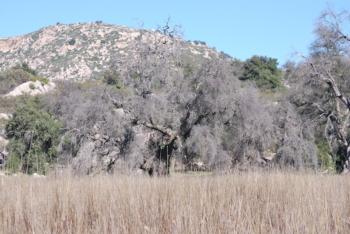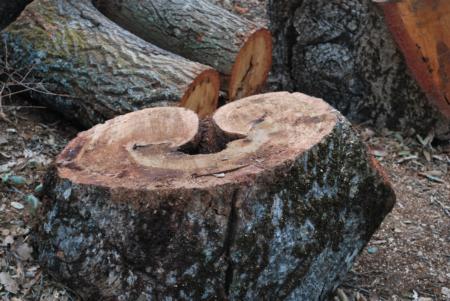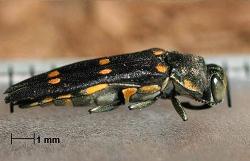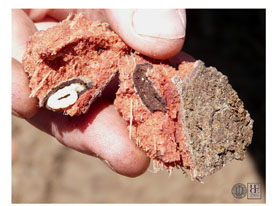About Goldspotted Oak Borer

GSOB larvae feed beneath the bark of certain oaks near the interface of the phloem and xylem, the nutrient and water conducting tissues of plants. The larvae damage both of these tissues as well as the cambium, a unicellular layer between the phloem and xylem that is responsible for the radial growth of the tree. Trees die after several years of injury inflicted by multiple generations of the beetle, causing significant economic, ecological, cultural, and aesthetic losses to the region. GSOB poses a major threat to susceptible oak species throughout California and southern Oregon. Currently there are no effective tools for saving trees once a major infestation occurs, although management and damage mitigation is possible in low-level infestations.
Source: Goldspotted Oak Borer Field Identification Guide (University of California IPM, January 2011)
Identification
Learn how to identify GSOB adults, larvae, and oak damage. Resources to help you evaluate oak tree health and diagnose goldspotted oak borer infestation. Sampling information and reporting options are offered as well.
Distribution
See a map of discovered goldspotted oak borer infestation areas in San Diego County.
Host Oaks
Pest Impact
FAQs
We have provided answers to some of the most frequently asked questions concerning GSOB.
Management Options
Brief discussions and resources regarding regarding community preparedness, infested live trees, chemical control and other management options.
Firewood
For information on why you shouldn't move oak firewood, availability, management practices, and additional information on GSOB and firewood.
GSOB Management Storymap (external link)
View an interactive GIS storymap outlining GSOB distribution, management guidelines, preventative treatment strategies, and more!




History of GSOB in California
According to museum records, GSOB has been documented in its native range in southeastern Arizona since the late 1800s. A related species occurs in southern Mexico and northern Guatemala. Its presence in California is likely due to the transport of oak firewood from its native range into new territories with host oak species.
GSOB was first collected in California in 2004, and oak damage associated with GSOB was first confirmed in the County of San Diego in 2008. However, elevated levels of oak mortality have been mapped aerially on and around the Cleveland National Forest since 2002. Subsequently, the invasive range of GSOB has expanded to parks, national forests, and communities throughout southern California, likely through transport of infested oak firewood (see updated Distribution maps here).
At present, there are no reports linking GSOB to oak mortality outside of California.
Read more about the goldspotted oak borer situation in the GSOB Issue Paper (January 2012).
